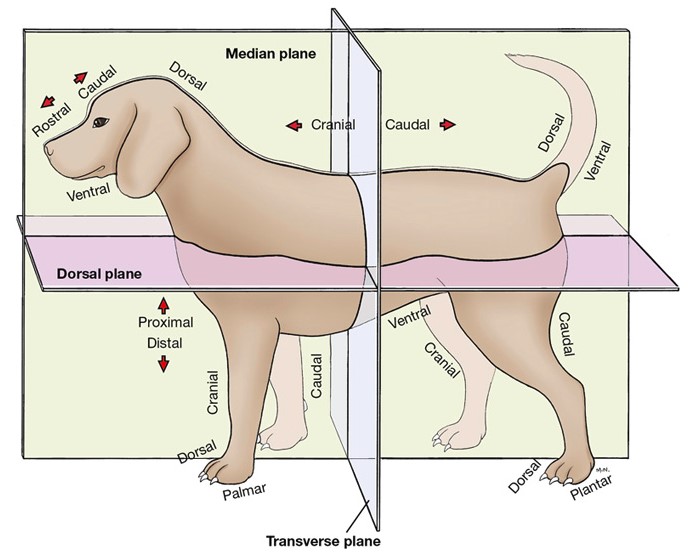Planes and Directional Terminology
The below content is adapted directly from “Guide to the Dissection of the Dog” and edited slightly.

PLANE: A surface, real or imaginary, along which any two points can be connected by a straight line.
Median Plane: Divides the head, body, or limb longitudinally into equal right and left halves.
Sagittal Plane: Passes through the head, body, or limb parallel to the median plane.
Transverse Plane: Cuts across the head, body, or limb at a right angle to its long axis or across the long axis of an organ or a part.
Dorsal Plane: Runs at right angles to the median and transverse planes and thus divides the body or head into dorsal and ventral portions.
DORSAL: Toward or relatively near the topside/backline/upper surface (as opposed to the supporting surface) of the head, body, and tail. This surface is opposite to the supporting surface in the standing animal. On the limbs it applies to the upper or front surface of the carpus, tarsus, metapodium, and digits (opposite to the side with the pads).
VENTRAL: Toward or relatively near the underside/supporting surface and the corresponding surface of the head, neck, thorax, and tail. This term is never used for the limbs.
MEDIAL: Toward or relatively near the median plane.
LATERAL: Away from or relatively farther from the median plane.
CRANIAL: Toward or relatively near the head; on the limbs it applies proximal to the carpus and tarsus. When on the head, it is replaced by the term rostral.
ROSTRAL: Toward or relatively near the nose; applies to the head only.
CAUDAL: Toward or relatively near the tail; on the limbs it applies proximal to the carpus and tarsus. When on the head, caudal is towards the back of the head, i.e. towards the tail.
The adjectives for directional terms may be modified to serve as adverbs by replacing the ending al with the ending ally, as in dorsally.
Certain terms whose meanings are more restricted are used in the description of organs and appendages.
INTERNAL or INNER: Close to, or in the direction of, the center of an organ, body cavity, or structure.
EXTERNAL or OUTER: Away from the center of an organ or structure.
SUPERFICIAL: Relatively near the surface of the body or the surface of a solid organ.
DEEP: Relatively near the center of the body or the center of a solid organ.
PROXIMAL: Relatively near the main mass or origin; in the limbs and tail, the attached end of that structure. ie moving up the limb or tail in closer proximity to the body attachment.
DISTAL: Away from the main mass or origin; in the limbs and tail, the free end of that structure. ie moving down the limb or tail more distant from the body.
In the carnivore, the paw is that part of the thoracic or pelvic limb distal to the radius and ulna or to the tibia and fibula. The human hand (manus) and foot (pes) are homologous with the forepaw and hindpaw, respectively. The equivalent anatomy is present in the ungulates (horse, cattle, goat, pig etc) and is usually referred to as the ‘distal limb’ region.
PALMAR: The thoracic limb digital surface that contacts the ground in the standing animal—and the corresponding surface of the metacarpus and carpus. For the carnivore, the aspect of the forepaw on which the pads are located.
PLANTAR: The pelvic limb digital surface that contacts the ground in the standing animal—and the corresponding surface of the metatarsus and tarsus. For the carnivore, the aspect of the hindpaw on which the pads are located.
DORSAL surface of limbs: The opposite surface of both palmar and plantar is known as the DORSAL surface of the limb, up to and including the carpus and tarsus.
AXIS: The central line of the body or any of its parts.
AXIAL, ABAXIAL: Of, pertaining to, or relative to the axis. In reference to the digits, the functional axis of the limb passes between the third and fourth digits in the carnivore and artiodactyls (cattle, goat, pig in our course) and down the center of the third digit in the horse. The axial surface of the digit faces the axis, and the abaxial surface faces away from the axis.
The following terms apply to the various basic movements of the parts of the body.
FLEXION: The movement of one bone in relation to another in such a manner that the angle formed at their joint is reduced. The limb is retracted or folded; the digit is bent; the back is arched dorsally.
EXTENSION: The movement of one bone upon another such that the angle formed at their joint increases. The limb reaches out or is extended; the digit is straightened; the back is straightened. Extension beyond 180 degrees is overextension.
ABDUCTION: The movement of a part away from the median plane.
ADDUCTION: The movement of a part toward the median plane.
CIRCUMDUCTION: The movement of a part when outlining the surface of a cone (e.g., the thoracic limb extended drawing a circle).
ROTATION: The movement of a part around its long axis (e.g., the action of the radius when using a screwdriver). The direction of rotation of a limb or segment of a limb on its long axis is designated by the direction of movement of its cranial or dorsal surface (e.g., in medial rotation of the arm, the crest of the greater tubercle is turned medially).
SUPINATION: Lateral rotation of the appendage so that the palmar or plantar surface of the paw faces medially.
PRONATION: Medial rotation of the appendage from the supine position so that the palmar or plantar surface will face the substrate.
Common regional synonyms include:
Brachium for the arm (between shoulder and elbow)
Antebrachium for the forearm (between elbow and carpus)
Thigh for the pelvic limb (between the hip and stifle)
Crus for the leg (between stifle and tarsus). The pelvic limb is not the ‘leg’. Only the crus is the true anatomic leg.
